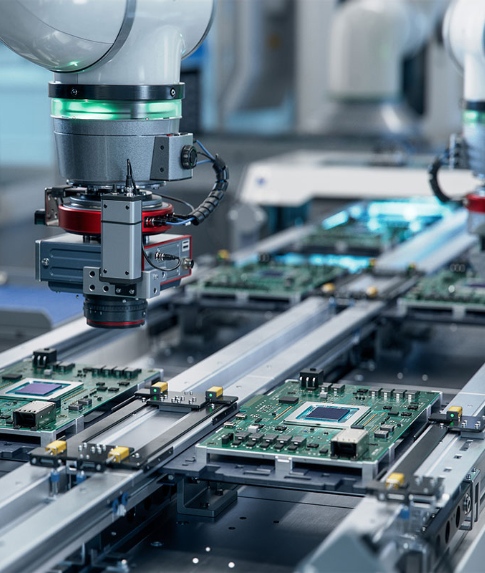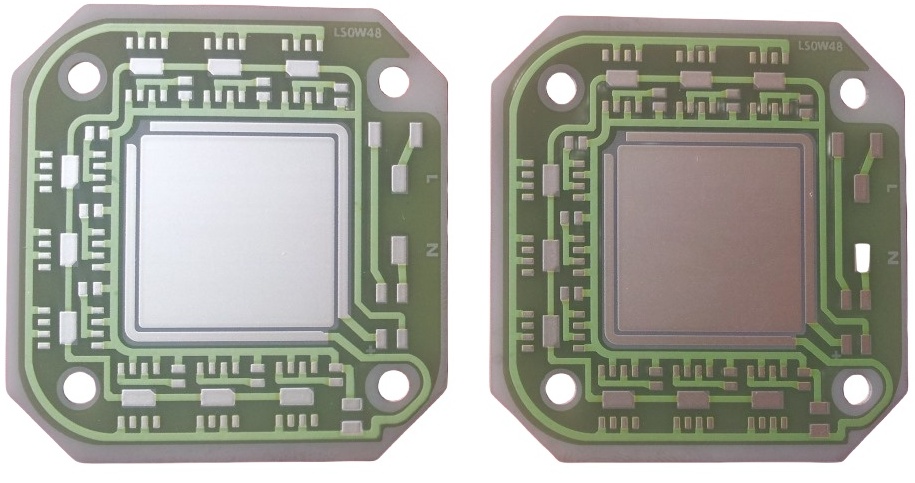


Ceramic PCB is a circuit board with ceramic material as the substrate, which plays a special role in electronic products. Compared with the common FR-4 material circuit board, ceramic PCB has more outstanding performance in thermal conductivity, insulation, high temperature resistance, etc., and is suitable for scenes with high performance requirements. The following introduces the basic knowledge of ceramic PCB from three aspects: materials, advantages, and applications.


The substrate of ceramic PCB is made of inorganic non-metallic materials, and common substrates include aluminum oxide (Al₂O₃), aluminum nitride (AlN) and silicon nitride (Si₃N₄), etc. These materials are formed into a dense structure by high-temperature sintering (usually over 1600°C).
1. Alumina (Al₂O₃):It is commonly used in the electronics industry, has good mechanical, thermal and electrical properties, is rich in raw materials, and is suitable for a variety of technical manufacturing. It has different purities such as 75%, 96%, and 99%. The thermal conductivity of 96% alumina is about 25.0 W/(m·K), and the thermal expansion coefficient is 4.5 to 10.9×10⁻⁶/K.
2. Aluminum Nitride (AlN):Non-oxide semiconductor technology-grade ceramic materials have a thermal conductivity of up to 80 to 300 W/(m·K) and a thermal expansion coefficient of 4 to 6×10⁻⁶K⁻¹ (20 to 1000°C), which matches silicon wafers and is suitable for high current and high temperature environments.
3. Beryllium Oxide (BeO):Its thermal conductivity is higher than that of metal aluminum and it is used in high thermal conductivity occasions. However, its thermal conductivity decreases rapidly when the temperature exceeds 300°C, and it is toxic, which limits its development. Its melting point is 2570°C, thermal conductivity is 200-250W/(m·K), and dielectric constant is 6-7 (0.1MHz).
4. Silicon Carbide (SiC):It has high thermal conductivity, high strength, high fracture toughness, and a thermal expansion coefficient that matches that of silicon, but it is difficult to manufacture, has low resistance and insulation, and is suitable for use in laser fields, etc.
5. Silicon Nitride (Si₃N₄):High thermal conductivity, high strength, high fracture toughness, thermal expansion coefficient matching that of silicon, good mechanical strength, suitable for IGBT modules, vehicle-mounted modules, etc., but the combination of the circuit layer and the substrate is unstable during manufacturing.
The thermal conductivity of ceramic PCB is significantly higher than that of FR-4 (epoxy resin substrate). For example:
· The thermal conductivity of alumina ceramics is about 20-30 W/(m·K);
· Aluminum nitride ceramics can reach 150-200 W/(m·K);
· Silicon nitride ceramics are about 80-120 W/(m·K).
High thermal conductivity can quickly dissipate heat to prevent electronic components from being damaged by overheating, and is suitable for high-power devices (such as LEDs and IGBT modules).
Ceramics are natural insulators with a volume resistivity of up to 10¹³-10¹⁵ Ω·cm, much higher than FR-4 (about 10¹² Ω·cm). Using ceramic PCBs in high-voltage circuits (such as power modules) can reduce the risk of leakage and improve safety.
The temperature range of ceramic PCB is usually -55℃ to 850℃ (FR-4 is about -55℃ to 130℃), and the coefficient of thermal expansion (CTE) is close to that of chip materials (such as silicon). When the temperature changes, the ceramic substrate is not easy to deform, which can reduce the problem of solder joint cracking or delamination, and is suitable for extreme environments such as automotive engines and spacecraft.
The dielectric constant (about 8-10 for alumina and about 8.8 for aluminum nitride) and dielectric loss (tanδ<0.002) of ceramics are low, with low attenuation and delay during high-frequency signal transmission, making them suitable for high-frequency equipment such as 5G communications and radars.
· LED lighting: High-power LED chips generate a lot of heat, and the high thermal conductivity of ceramic PCBs can extend their life (experiments show that aluminum nitride substrates can reduce LED junction temperature by 30%-50%).
· New energy vehicles: IGBT modules need to withstand hundreds of amperes of current and 200°C high temperature, and ceramic PCBs can work stably.
High-frequency equipment such as 5G base stations and millimeter-wave radars require low-loss circuit boards. The low dielectric constant and dielectric loss of ceramic PCBs can reduce signal attenuation and improve transmission efficiency.
Satellites, rockets and other equipment need to work in a vacuum, radiation, and drastic temperature difference environment. The inorganic material properties of ceramic PCBs (anti-radiation, aging resistance, and thermal shock resistance) make them a key choice.
Implantable medical electronics (such as pacemakers) and high-precision imaging equipment (such as CT machines) have extremely high requirements for the insulation and stability of circuit boards. Ceramic PCBs can meet the needs of long-term reliable operation.
Ceramic PCBs play an irreplaceable role in high-power equipment, communications, aerospace, medical and other fields due to their strong thermal conductivity, good insulation, high temperature resistance and excellent high-frequency performance. Despite the high cost, their reliability and performance advantages make them a key material for high-end electronic products. In the future, with the advancement of technology and the reduction of costs, the application scenarios of ceramic PCBs will be further expanded.
Our hours
24H